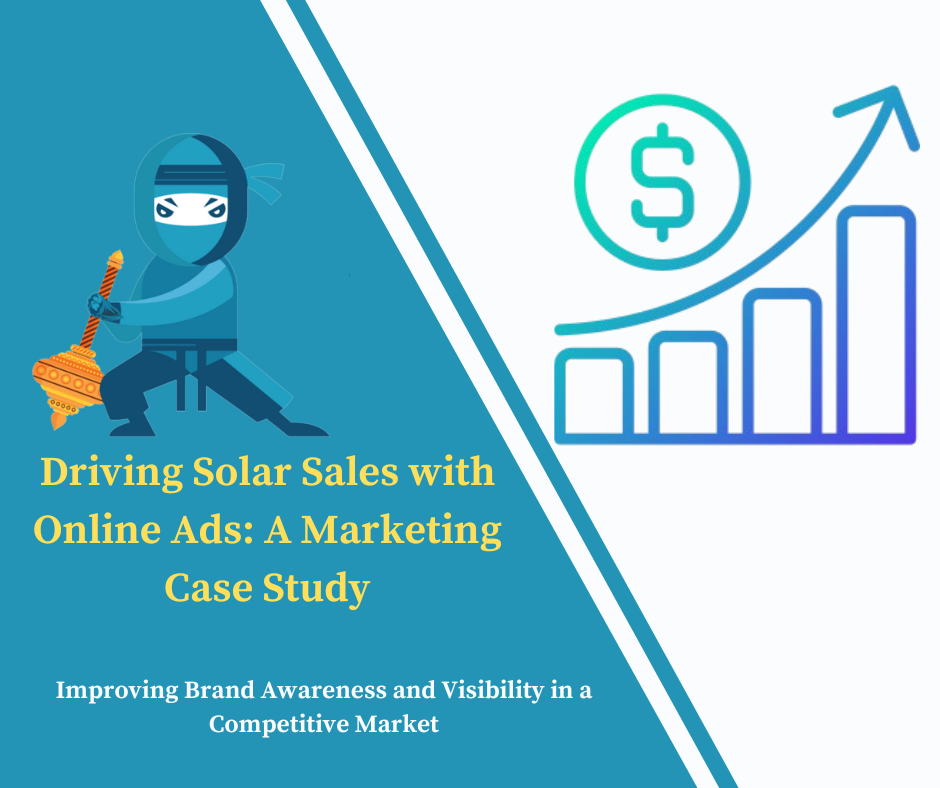Driving Solar Sales with Online Ads: A Marketing Case Study
In the competitive landscape of solar energy, driving sales requires more than just quality products; it necessitates effective marketing strategies. Online advertising has emerged as a powerful tool for boosting solar sales, allowing companies to reach targeted audiences with precision. This case study explores how a targeted online ad campaign significantly enhanced solar sales, providing insights into strategies that can be applied across the industry.
This marketing case study examines the journey of Solar Bright, a solar panel company facing stagnant sales despite its high-quality offerings. The company turned to online advertising to revitalize its sales strategy. The study explores the methods employed, including audience segmentation, ad content creation, platform selection, and budget optimization. It highlights how Solar Bright’s targeted ad campaign not only increased website traffic but also improved conversion rates and drove substantial sales growth. Through this case study, readers will gain insights into effective online ad strategies and learn practical lessons for enhancing solar sales in a competitive market.
The Challenge
A solar panel company, Solar Bright, faced a significant challenge: despite having a high-quality product and excellent customer service, their sales were stagnating. The company needed a strategy to increase visibility, attract potential customers, and convert leads into sales. Their goal was clear: drive more solar panel sales through effective online advertising.
Strategy and Implementation
1. Audience Segmentation
To ensure the online ads reached the right people, Solar Bright started by defining their target audience. They segmented their audience based on demographics, location, and online behavior. This approach allowed them to tailor their messages to different segments, including homeowners interested in energy savings, environmentally conscious individuals, and businesses looking for sustainable solutions.
2. Creating Compelling Ad Content
The next step involved crafting compelling ad content that resonated with each segment. Solar Bright focused on several key elements:
Value Proposition: Ads highlighted the benefits of solar panels, such as cost savings, energy efficiency, and environmental impact.
Strong Call-to-Action (CTA): Clear and persuasive CTAs encouraged users to take immediate action, such as requesting a quote or scheduling a consultation.
Visual Appeal: High-quality images and engaging videos showcased the solar panels in various settings, making the ads visually appealing.
3. Choosing the Right Platforms
Solar Bright used multiple online advertising platforms to maximize their reach:
Google Ads: Targeted search ads were used to capture intent-driven traffic. Keywords like “solar panel installation” and “best solar deals” were bid on to ensure high visibility in search results.
Facebook and Instagram Ads: These platforms allowed for detailed demographic and interest-based targeting. Solar Bright ran carousel ads and video ads to engage users scrolling through their feeds.
LinkedIn Ads: For B2B opportunities, LinkedIn ads targeted businesses and commercial property owners interested in solar energy solutions.
Also read: How User-Friendly Web Design Can Boost Small Solar Sales?
4. Optimizing Ad Spend
To ensure the advertising budget was used effectively, Solar Bright employed a data-driven approach:
A/B Testing: Different ad variations were tested to determine which performed best in terms of click-through rates (CTR) and conversions.
Retargeting: Users who visited the website but didn’t convert were retargeted with personalized ads to remind them of the benefits and prompt them to return.
Performance Tracking: Metrics such as CTR, conversion rate, and cost-per-acquisition (CPA) were closely monitored. This allowed for real-time adjustments to the campaign for better results.
Results
The online ad campaign led to significant improvements in Solar Bright’s sales performance:
Increased Website Traffic: The targeted ads drove a 45% increase in website traffic, with a notable rise in visits to the product pages.
Higher Conversion Rates: Conversion rates improved by 30%, thanks to the compelling ad content and effective retargeting strategies.
Sales Growth: Overall sales increased by 25%, demonstrating the direct impact of the online ad campaign on solar panel sales.
Key Takeaways
The success of Solar Bright’s campaign offers several valuable lessons for other solar companies looking to boost their sales through online advertising:
Understand Your Audience: Effective segmentation and targeting are crucial. Tailor your ads to meet the specific needs and interests of different audience segments.
Craft Engaging Content: Your ad content should communicate the benefits of your product and include strong CTAs to drive action.
Utilize Multiple Platforms: Leverage various online advertising platforms to reach a broader audience and increase your chances of conversion.
Monitor and Optimize: Continuously track ad performance and make data-driven adjustments to maximize your return on investment.
FAQ
What types of online ads are most effective for driving solar sales?
The most effective types of online ads for driving solar sales include search ads on Google, social media ads on platforms like Facebook and Instagram, and retargeting ads. Each type plays a role in reaching potential customers at different stages of their decision-making process.
How can I measure the success of my online ad campaign for solar sales?
Success can be measured using various metrics, including click-through rates (CTR), conversion rates, cost-per-acquisition (CPA), and overall sales growth. Tools like Google Analytics and ad platform insights can provide valuable data on campaign performance.
What is the importance of retargeting in driving solar sales?
Retargeting is crucial because it allows you to re-engage users who have previously shown interest but didn’t convert. By keeping your brand top-of-mind and presenting tailored offers, you increase the likelihood of converting these potential customers into actual sales.
How can I optimize my online ad spend for better results?
Optimize your ad spend by using A/B testing to find the most effective ad variations, employing retargeting strategies to re-engage previous visitors, and continuously monitoring performance metrics to adjust your budget allocation based on what works best.
Can online ads help with both residential and commercial solar sales?
Yes, online ads can be tailored to target both residential and commercial audiences. Platforms like LinkedIn are particularly useful for B2B advertising, while Facebook and Instagram are effective for reaching residential customers.
Conclusion
Online advertising has proven to be a game-changer for driving solar sales. By understanding their audience, creating compelling ad content, choosing the right platforms, and optimizing their ad spend, Solar Bright achieved remarkable results. Solar companies looking to enhance their sales should consider implementing similar strategies to harness the power of digital marketing effectively. By focusing on data-driven decision-making and leveraging the full potential of online ads, businesses in the solar industry can achieve significant growth and drive their sales to new heights.








